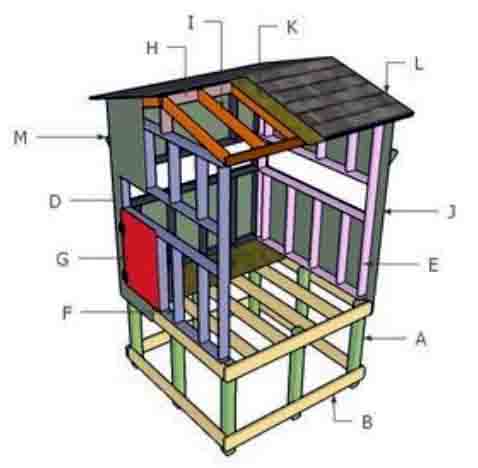Searching for the easiest way of building a ground blind at your home? Well, that’s enough, your long quest is finally complete. Today, we’re learning how you can make cheap DIY ground blinds that work the same as the more expensive ones.
Check out our easy-to-follow guide and let us know how it went for you. But if you think you’re not a good DIYer, look for the most suitable ground blind you can build, so this season doesn’t go in vain.
How to Make DIY Ground Blinds for Deer Hunting: Step-By-Step
Tools Needed
For a natural ground blind, you’ll need:
- A pair of loppers that can cut up to 3 inches
- A pair of hand pruners for trimming
- A different-sized linesman plier
- A brush blade
- A tape measure
- A hammer
- A wire (clothesline, jute twine, cotton cord)
- Saplings of different sizes
- Nails
For a simple ground blind, you’ll need:
- A pair of wire cutters
- A circular saw
- A cordless drill
- A carpenter square
- A hammer
- A tape measure
- A sharp knife
- A number of different-sized pressure-treated lumber
- A cattle panel
- A black plastic sheet
- A campo tra
1. Cutting the Main Supports
For the natural ground blind, use thicker and stronger saplings to get a sturdy structure. Find saplings whose diameter is almost 2-3”. Most people prefer a spacious 60” inside square and 42-80”, but it’s better to measure as per your needs.
For the height, cut 6-8 saplings as required. For the width, cut 8-10 saplings as per requirement. As a safety measure, cut the saplings 2-4 inches longer than required.
For the simple version, use pressure-treated lumber instead of saplings. For a 6’×8’ blind, you need 9 pressure-treated lumbers: 4 of 2×6×8’ and 5 of 2×4×8’. These are ready-made, so not much effort is needed, unlike the natural blind.
2. Building The Frame Foundation
Frame building is another vital step; a frame is on which the whole structure stands erect. Therefore, it must be strong.
For the natural blind, use four identical saplings. Bind them together to make a square-shaped frame. Use a long nail and hammer it through the saplings or use a 10” strong cord to make the corners.
For the simple version, use 4 pressure-treated lumbers of 2×4×8 to build the blind’s base frame. Use two 8-feet long lumbers for the length and two 6-feet long ones for the width. Now, screw them together to make a square-shaped frame.
3. Making the Roof
In the natural blind, you can use some bushes and leaves to build the roof. Use a simple wire to tie this vegetation to the posts. This type of roof will be free of cost and less suspicious.
However, it won’t be waterproof, so not a good option in the rain.
In the simple one, use a simple wrap of 16’-long cattle panels: their flexible nature can help you bend them and get a dome or hay bale shape.
Moreover, you can fix it with the lumbers using screws. This roof can prevent you from harsh weather conditions.
4. Making Outer wall frame

In the natural blind, attach 2 saplings horizontally to the already added saplings post: one on the floor and another on the roof side. When you attach these saplings to the post, it’ll make a square.
To make it sturdy, attach some diagonal pieces of saplings. Use almost 10 inches of wire to wrap around every joint. Similarly, build the other walls except for the back wall.
Keep a 20-inch door upright space in that wall, as you leave space for the window in others. Lastly, assemble all walls with the wire or hammer the nails.
For the simple type, make two frames: the front and the back. The front will locate the window, and the back will have the door.
In the front wall, add 4 lumbers. Stand 2 lumbers vertically and attach 2 horizontally where you want to leave the window space.
In the back wall, you need 3 lumbers. Erect 2 lumber and fix 1 on the roof edges of the erected ones.
5. Covering the Sides of the Blind
This is quite similar to roof making.
For the sapling structure, cut shrubs and leafy branches to cover the frame. After completing some part of the frame with the limb and leaves, step back to find any uncovered area.
Cover that area and blend it to camouflage. Keep the window space free from any covering to get a clear aim.
For the lumber structure, attach a black plastic sheet to the blind’s base and frames. It’s essential to hide from the prey; that’s why a ground blind is usually dark to hide the hunter’s movement.
Cover that sheet with camo traps and cut the flap for the door and window, but don’t detach these cuts. Instead, roll them up so you can roll them down when needed.
6. Finishing the Interior
For the sapling structure, go inside to check if it’s comfortable. Trim all the extra branches from the sidewalls that are coming through your way with loppers and hand pruners.
Sometimes, when aiming, you need to move. Always ensure to move silently and don’t crunch any leaf. Furthermore, be careful about the smell.
For the lumber structure, you have a lot of materials to hide your movement. So, you have a little liberty when moving around the blind.
However, be careful about the noisy leaves on the ground. Other than that, you are good to go.

DIY Hunting Blind Plans You Can Make
Free-Standing Deer Blind
A free-standing or ground deer blind is like a phone booth: it’s only for one person. You can make this blind in a short time with ease. If you’re planning to build one before the next season, go for it. For this type of DIY ground blind, you need:
- Lumbers of different sizes
- Plywood sheets
- Stand brackets
- Basic woodwork tools for assembling
First, use lumbers to make the floor frame and then panel it with plywood. Then, build and panel the four walls, three with the window and one with a door.
Finally, assemble all the walls with the floor frame and install the roof.
Elevated Deer Blind
An elevated deer blind has many types, and the most common ones are the 6×6 and 4×8 blinds. The structure of this blind is sturdy and spacious, so it can hold several people at once. Its material and tools are relatively similar to the free-standing deer blind.
You can easily make your own DIY elevated deer blind. First, make a floor frame and then install 4 posts. Don’t forget the rule – the stronger, the better.
Fix the floor frame on the post and panel and then build the wall frame and panel. Keep the space for the window and door in the wall frame. Now attach these walls to the floor and make the roof with the rafter.
Hay Bale Blind
A hay bale blind offers a friendly sight to the prey, so it can’t suspect the hunter. The materials mainly used for this blind include:
- Few treated lumbers
- Plywood sheets
- A rough pine board
- A black plastic sheet
- A wire fence
- A bale wrap
Start by building a floorless base. Use plywood sheets to build 2 walls: one with a door and one with windows. Then, build the window frame with pine boards and windows with plywood.
Use 2 lumbers for roof framing. Wrap the remaining 2 sides with welded wire and cover them with the black plastic sheet. In the end, layer the bale wrap on the plastic sheet.
All-Natural DIY Ground Blind
If you want an inexpensive blind and disguise with a huge realistic look, one of the best spacious ground blinds is made using saplings. This has been defined above step-by-step.
Besides that, you can make some others with little materials like shrubs, branches, and leaves. For this, you don’t need a miter saw or other machines; just some loppers and pliers can do the trick.
All you have to do is use saplings instead of lumbers for framing and wires for fixing them. In the end, use different leaves and branches for wrapping around.
Deer Stand Visual Aid
A deer stand visual aid is more like an elevated stand. It’s very simple to make. To make this stand, you need some small-size lumbers, plywood, screws/nails, and that’s pretty much all.
This stand can be assembled with a hammer, screwdriver, and tape measure.
You need to make a square and attach it with the legs, then build and panel a floor frame with plywood and attach it with the legs to make a stool. Now lastly, do the bordering.
Conclusion
We believe that now with our help, building your own ground blind from scratch will be just a matter of minutes. And setting up your ground blind is easy as well.
We’re eager to hear how you found the right place to make the blind and how it all went for you. Make use of the comments section below.
FAQs
1. Do ground blinds spook deer?
Ans. Unfortunately, yes! Even the scent from your hunting blind chair could scare them off. There are several reasons for this: the deer is a very agile animal with a great sense of smell, hearing as well as sight.
2. What is the easiest ground blind to set up?
Ans. It’s a matter of choice, but most people lean towards the meristems because they are super easy to set up and clean. So, we suggest that you have a taste of this blind.
3. Do I have to brush in a ground blind?
Ans. Yes. Brushing in gives a more chameleon look to the ground blind. It hides its actual box-like shape and helps the blind mix with the forest habitat. The more vegetation, the better.
You can use your deer attractants and wait for the game to come into your sight. Be careful that you don’t block your view.
4. Can I leave a ground blind out?
Ans. You can leave it out as long as the weather is not harsh because once it is unfriendly, it will get ripped apart. Sometimes, animals destroy it as well.









Leave a Comment